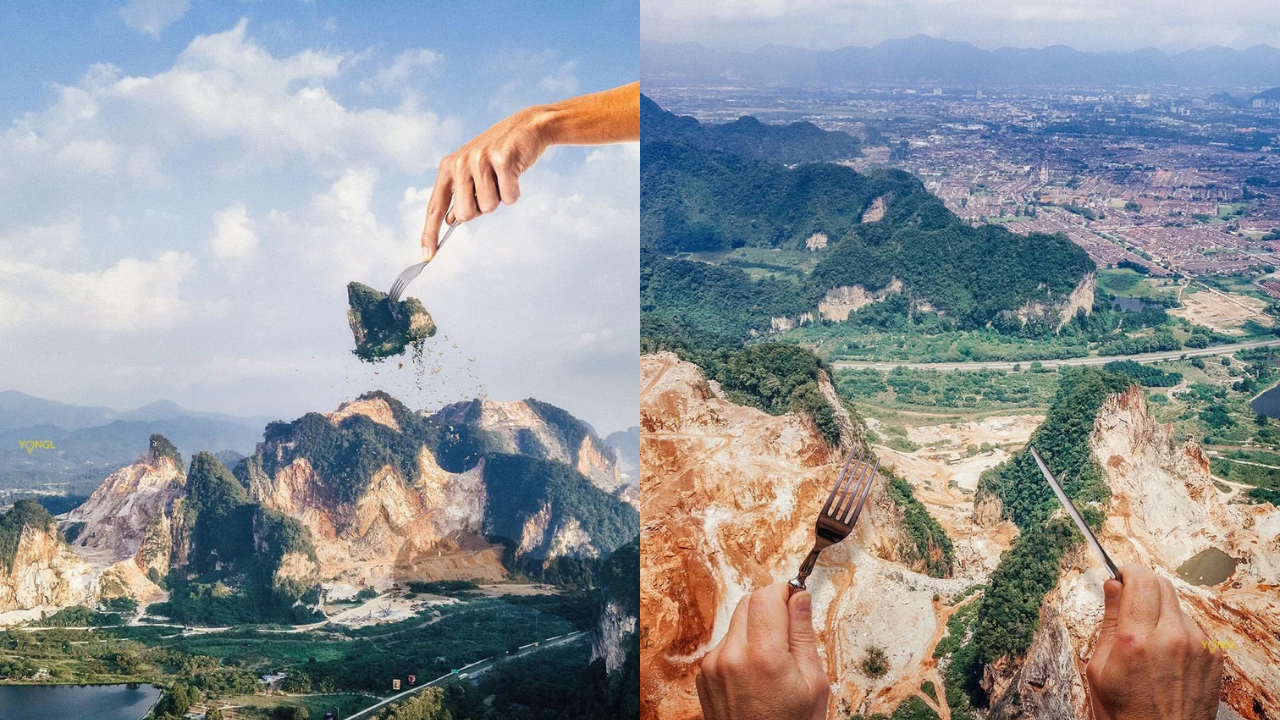In the past, former US President Donald Trump has bizarrely stated that climate change is a “hoax” but there is no doubt that a range of changes is happening on our planet including global warming. According to the London School of Economics and Political Science, when deforestation–– which is the purposeful clearing of thinning of trees and forest occurs, much of the carbon stored by trees is released back into the atmosphere as carbon dioxide, which contributed to climate change.
Photographer and digital artist Yong Lin Tan who runs his own small creative studio has innovatively reimagined Malaysia through his artwork in the past such as reimagining Malaysian food on local landscapes. He has also put his own spin on familiar landmarks such as the Petronas Twin Towers by transforming them into rockets lifting into space.
In one of his latest works, Yong raised awareness of the disappearing mountains of Ipoh in the Simpang Pulai area by making a digital artwork of a person’s hand using a fork to lift a part of the mountain, an ice cream scoop in another to ‘scoop’ up a portion of the hill, and even a razor to ‘shave’ a part of it off.

He initially came across a viral image of the hills of Ipoh on Facebook months ago which have been significantly deforested and looked surreal to him. In an Instagram video, he said, “I decided to actually visit the location to investigate the matter.” After asking for help from locals on his Instagram story he managed to get a GPS location.
He brought along his drone and arrived in Ipoh via the KTM ETS and then met up with a local who was familiar with the area around Simpang Pulai. The local man drove him around to get aerial shots of the area. As Yong said, “As you can see, most of the hills are going botak (bald). So, the once beautiful scenery around the area has now turned into an eye sore.”
At limestone quarries on the hills, processes such as blasting, blocking, hammering, and washing of the stones are carried out. Limestone composed mainly of calcium carbonate is typically melted in a high-temperature rotary kiln into a slurry and processed to make cement combined with other minerals. It is widely used in architectural applications for walls.
When Rojak Daily spoke to an Ipoh resident, they said, “The sound of blasting can occasionally be heard when you drive by if you are heading south from the capital city and these hills have become a blemish on the face of Ipoh.”
According to Yong, after carrying out his own research, he found that most of the private companies there are operating on lease and the limestone quarrying industry is one of the biggest contributors of Perak’s economy. He commented, “I think there is always a solution to balance the need for economic growth with the right practices that can restore or even protect the environment.”
According to the environment and sustainability journalism portal Macaranga, Perak far surpasses other Malaysian states in the extraction of the mineral which earns the state’s income and contributed RM457.5 million in 2020 to the state’s gross domestic production (GDP). Dato’ Nolee Ashilin Mohammed Radzi, the Perak Housing, Local Government and Tourism committee chairperson also shared to the portal that Perak is one of the key exporters of natural resources in the world.
Despite its monetary values, the hills also serve invaluable purposes such as biodiversity and ecosystem services, cultural and historical heritage, and religious and spiritual purposes as they house cave temples.
After Yong spoke to the locals residing there, most of them expressed concerns about the increasing temperature as well as the uncertain weather in Ipoh. They were also worried that the mining activities would spread to the other hills. After seeing the hills, Yong decided to create the aforementioned artworks with the idea of making look like humans are consuming the area.
Yong clarified that he was not a journalist or environmental activist and hoped that his actions would inspire others.
Image credit: @yongl95







